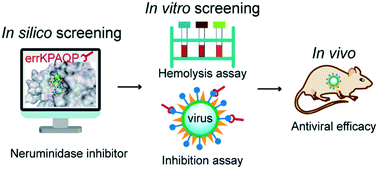Discovery and characterization of a novel peptide inhibitor against influenza neuraminidase
Abstract
Neuraminidase, an abundant glycoprotein on the influenza virus surface, plays crucial roles in virus replication. Targeting neuraminidase could be a splendid way for the prevention of the spread of influenza infections. Herein, we have identified an octapeptide (errKPAQP) from a synthesized peptide library, originating from mimicking the binding pocket of oseltamivir in neuraminidase, as a potent peptide neuraminidase inhibitor. The docking-based virtual studies showed that errKPAQP exhibited a strong binding affinity (a docking score of −20.03) and nanomolar affinity (11 nM) to influenza neuraminidase, and can inhibit neuraminidase activity at a concentration as low as 4.25 μM, leading to effective protection of MDCK cells from influenza virus-induced death and replication. Furthermore, errKPAQP presented low hemolytic activity, minimal cytotoxicity, and good pharmacokinetic characteristics, which are imperative for an anti-influenza drug. Importantly, errKPAQP was capable of reducing influenza virus-induced inflammation, the serious damage to the lung tissues, and mortality rates in infected mice, indicating that it could protect against the lethal challenge of influenza viruses in vivo. Therefore, we have developed a novel neuraminidase peptide inhibitor with advantageous biological properties and high inhibitory activity towards neuraminidase, and it can serve as a promising anti-influenza drug.



 Please wait while we load your content...
Please wait while we load your content...